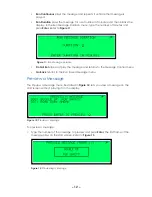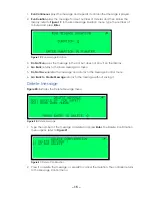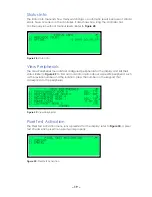
– 6 –
Connect the RJ45 connector to J11 and route the cable in conduit to J3 or J4 on the
CAN distribution board. The cable should have some slack after it has been connected.
J12 of the VFC-3000 controller is reserved for future use.
Note:
Signal cables and power wires must be pulled in separate conduits, separated
by several inches. Daktronics recommends using metallic conduit to reduce
electromagnetic interference from the power wires.
VFC-3000 Controller Communications (J1, J5-J9)
The VFC-3000 controller can interface to the central controller via several different
communication types, including RS232, RS422, modem, and Ethernet. The controller
is capable of simultaneous communications on any of the communication ports;
meaning the VFC-3000 controller can be operated by the central controller and by
on-site personnel at the same time. Communications equipment interconnections and
configuration must be correct before the central controller computer can communicate
with the VFC-3000 controller and other remote equipment.
At the central control computer, ensure:
• The correct software is running on the central control computer.
• The software display database for each display is correct. Refer to the software
controller operation manual for configuring the display database.
• The communication cables and devices are operational.
• The communications software parameters are correct for each display.
At the display site, ensure:
• The controller, communication devices, and cables are installed and operational.
•
The controller communication ports are properly configured.
• The controller address is correct.
Central Control Ports (J8, J9)
The central control ports are the primary communication channels between the central
controller and the VFC-3000 controller. Central control port J8 is an RS232 port, and
port J9 is an RS422 port. Only 1 of these interfaces can be used at a time. The RS422
port is capable of connections up to 4,000' (1,219 m), while the RS232 port is capable of
interfacing to any number of media converters or modems. The default configuration for
these ports is Point-to-Multi-Point Protocol (PMPP), no handshaking, at 9,600 bps; refer to
to configure the central control port.
The control capabilities of these ports depend on the state of the Local indicator LED
on the front interface panel. When the VFC-3000 controller is in local mode, the central
controller is limited to status retrieval information. When the VFC-3000 controller is in
remote mode, the central controller can fully control the display.










































